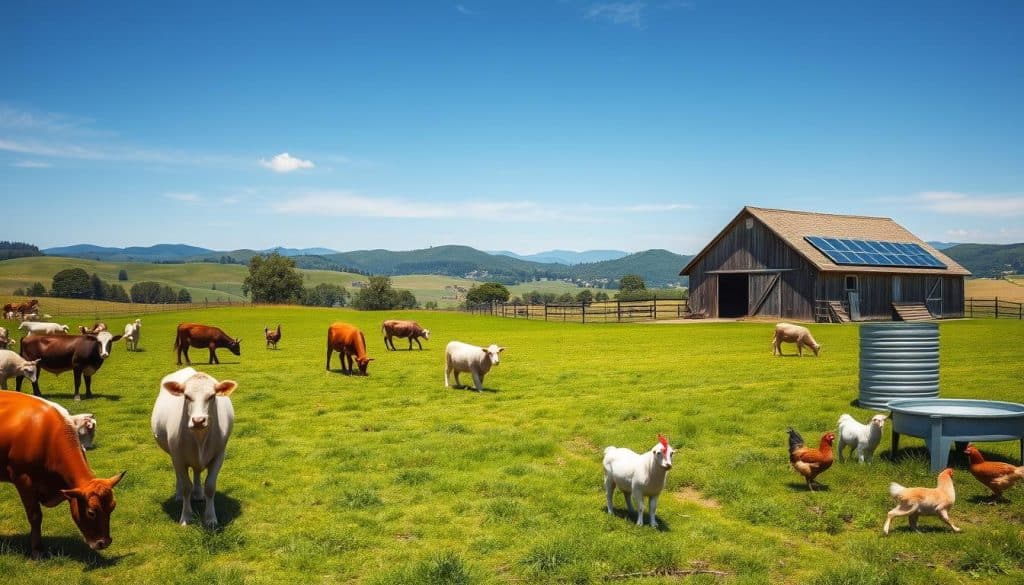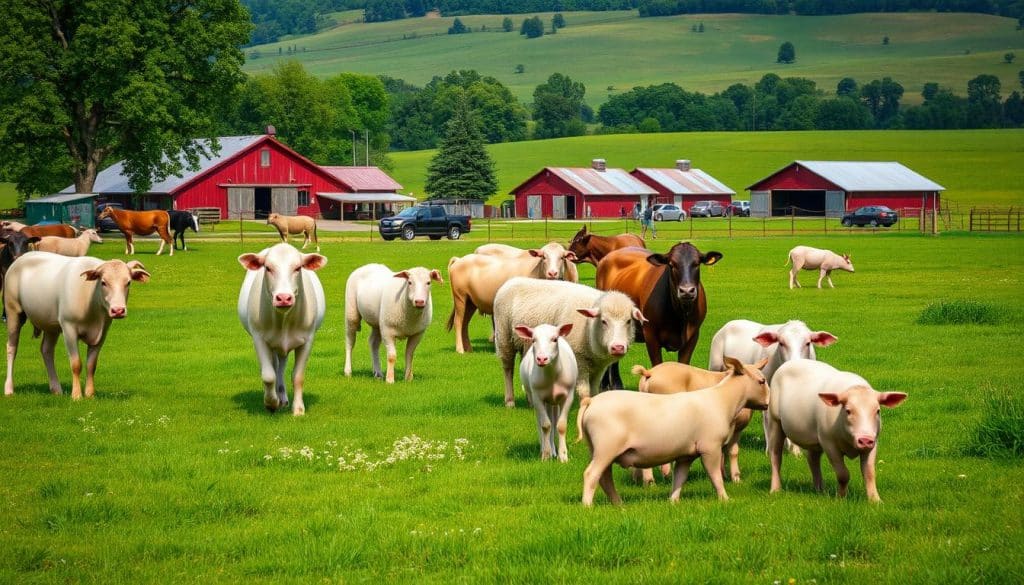The global livestock farming industry adds over $1.4 trillion yearly to the world economy. This highlights the vital role of effective animal husbandry and agricultural management strategies.
Modern livestock farming blends scientific knowledge, practical skills, and strategic planning. Farmers face complex challenges that require innovative approaches to agricultural sustainability. It’s about creating resilient, productive agricultural ecosystems, not just raising animals.
Successful livestock management requires understanding animal health, nutrition, and breeding techniques. Farmers must also grasp market dynamics to thrive in this field.
Today’s agricultural practices demand a mix of scientific, economic, and caregiving skills. Farmers need to wear multiple hats to succeed in this dynamic industry.
Key Takeaways
- Understand the economic significance of livestock farming
- Develop comprehensive management strategies
- Integrate scientific approaches with practical experience
- Focus on sustainable agricultural practices
- Continuously update knowledge and skills
Understanding the Basics of Life Stock
Livestock management is a complex part of agricultural production. It’s the backbone of sustainable food systems. Domesticated animals provide essential resources and economic opportunities in global agriculture.
What is Livestock?
Livestock are domesticated animals raised for agricultural purposes. They contribute to livestock production through meat, milk, eggs, and fiber. Farm animals have unique traits and management needs.
- Cattle: Primary sources of beef and dairy products
- Sheep: Wool and meat production
- Goats: Milk, meat, and fiber resources
- Poultry: Egg and meat generation
- Pigs: Meat production and agricultural waste management
Importance of Livestock in Agriculture
Livestock management is more than just raising animals. These animals provide crucial ecosystem services. They fertilize soil through manure and support biodiversity.
Farmers use livestock as dynamic agricultural assets. These assets create multiple economic and environmental benefits.
“Livestock are not just animals; they are integral components of sustainable agricultural systems.” – Agricultural Research Institute
Types of Livestock
Different livestock categories need specific management strategies. Understanding each type’s needs ensures good livestock production and animal welfare.
| Livestock Type | Primary Purpose | Key Management Considerations |
|---|---|---|
| Dairy Cattle | Milk Production | Nutrition, Breeding, Regular Health Checks |
| Beef Cattle | Meat Production | Grazing Management, Growth Monitoring |
| Sheep | Wool and Meat | Shearing, Parasite Control |
Benefits of Effective Life Stock Management
Effective livestock management is crucial for farmers in the livestock industry. It boosts productivity and sustainability. Strategic approaches offer advantages in economics, environment, and animal welfare.
Economic Advantages of Sustainable Livestock Farming
Sustainable livestock farming brings strong economic benefits to farmers. It can greatly improve farm profitability. This happens through better management strategies.
- Reduced operational costs
- Enhanced animal productivity
- Higher quality product output
- Improved breeding efficiency
| Management Strategy | Economic Impact |
|---|---|
| Optimized Feeding | 15-20% Cost Reduction |
| Genetic Selection | 10-25% Productivity Increase |
| Health Monitoring | Reduced Veterinary Expenses |
Environmental Benefits
Smart livestock management helps solve environmental problems. Sustainable practices can greatly reduce harm to nature. This is done through new methods.
- Precision grazing techniques
- Advanced waste management systems
- Carbon sequestration strategies
“Effective livestock management is not just about productivity, but about creating a balanced ecosystem that supports long-term agricultural sustainability.”
Improved Animal Welfare
Good livestock management makes animals healthier and happier. It gives them the best food, care, and living spaces. This leads to better results.
- Reduced stress levels
- Enhanced immune response
- Improved reproductive performance
Farmers who use these methods can change their livestock operations for the better. They create stronger, more productive farms. This approach leads to lasting success in agriculture.
Essential Life Stock Record Keeping
Livestock management thrives on careful record keeping. Farmers who track herd details gain advantages in productivity and efficiency1.
Types of Records to Maintain
Top livestock managers keep detailed records across various categories:
- Animal identification details
- Breeding history
- Health and vaccination records
- Feed consumption tracking
- Production performance metrics
Digital Tools for Record Keeping
Modern farming uses tech solutions for better record management. Digital livestock software helps farmers in many ways.
It allows them to gather data in one place. They can create reports and track animal histories easily.
- Centralize data collection
- Generate performance reports
- Track individual animal histories
- Analyze herd-wide trends
| Record Type | Key Information | Tracking Frequency |
|---|---|---|
| Health Records | Vaccinations, treatments, medical history | Continuous |
| Breeding Records | Mating dates, genetic lineage | Seasonal |
| Nutrition Logs | Feed types, consumption rates | Daily |
Best Practices for Data Entry
Keeping accurate livestock records needs discipline and consistency. Precise data entry helps farmers make smart choices and follow farm rules.
“Good record keeping is the foundation of successful livestock management” – Agricultural Expert
Strong record-keeping turns raw data into useful farm insights. This boosts farm productivity and helps it last longer.
Nutrition and Feeding Strategies for Life Stock
Nutrition is crucial for successful livestock farming. It requires understanding dietary needs and feeding approaches. These support animal health and productivity in animal husbandry strategies.
Proper nutrition affects all aspects of livestock performance. This includes growth rates and reproductive capabilities. Farmers must create feeding plans for different animal species.
Importance of Balanced Diet
A balanced diet provides essential nutrients for animal development. Key components include:
- Protein for muscle growth
- Carbohydrates for energy
- Minerals for metabolic functions
- Vitamins for overall health
Common Nutritional Requirements
| Animal Type | Protein Needs | Energy Requirements |
|---|---|---|
| Cattle | 12-16% | High during lactation |
| Sheep | 10-14% | Moderate |
| Goats | 14-18% | High during pregnancy |
Supplements and Feed Types
Strategic supplementation can fill nutritional gaps in livestock diets. Common feed types include:
- Pasture grasses
- Hay and silage
- Grain mixes
- Commercial feed blends
“Nutrition isn’t an expense, it’s an investment in your livestock’s future productivity.” – Agricultural Nutrition Expert
Precise nutrition management helps farmers boost animal health. It also cuts waste and improves farm efficiency. This approach benefits overall livestock farming.
Health Management and Veterinary Care
Livestock management requires a proactive approach to animal health. Successful animal husbandry depends on comprehensive veterinary care and health monitoring. Protecting your livestock means understanding strategies that prevent disease and promote wellness.
Preventive healthcare is crucial for successful livestock management. Farmers must develop strong strategies to maintain herd health. These strategies help minimize potential risks to animals.
Regular Health Check-ups: Essential Monitoring
Routine vet exams can detect health issues early. Critical aspects of health monitoring include several key factors.
- Physical body condition assessments
- Weight tracking
- Reproductive health screening
- Parasite detection
Vaccination Schedules: Protecting Your Herd
Targeted vaccination protocols help prevent infectious diseases. Customized vaccination strategies should address specific regional health risks. These strategies should also consider different livestock types.
| Livestock Type | Core Vaccines | Frequency |
|---|---|---|
| Cattle | Bovine Respiratory Syncytial Virus | Annually |
| Sheep | Clostridial Diseases | Bi-annually |
| Goats | Caprine Arthritis Encephalitis | Annually |
Common Health Issues to Monitor
Good animal husbandry requires careful watching for health concerns. Key areas to watch include several important factors.
- Respiratory infections
- Metabolic disorders
- Reproductive complications
- Nutritional deficiencies
“Prevention is always more cost-effective than treatment in livestock management.” – Agricultural Health Expert
Work closely with a vet who knows your livestock type. This ensures good health management and quick emergency response2.
Sustainable Life Stock Practices
Sustainable livestock farming balances productivity with environmental responsibility. Farmers now focus on protecting animal welfare and ecosystem health. This approach is crucial for modern agriculture.
Defining Sustainable Practices
Sustainable livestock practices aim to minimize environmental impact while maintaining economic viability. These strategies involve efficient resource management and reducing carbon footprint.
They also focus on protecting animal welfare and maintaining soil health.
- Efficient resource management
- Reducing carbon footprint
- Protecting animal welfare
- Maintaining soil health
Crop-Livestock Integration
Integrating crops and livestock creates a powerful synergy in sustainable agriculture. This approach allows farmers to diversify their income streams and improve overall farm ecosystem.
| Integration Strategy | Benefits |
|---|---|
| Cover Crop Grazing | Improves soil fertility, reduces erosion |
| Manure Fertilization | Reduces chemical fertilizer dependency |
| Integrated Pest Management | Natural pest control, reduced chemical use |
Rotational Grazing Benefits
Rotational grazing is key in sustainable livestock management. It involves moving animals between different pasture areas.
This strategy prevents overgrazing and enhances pasture regeneration. It also improves animal nutrition and increases soil carbon sequestration.
- Prevent overgrazing
- Enhance pasture regeneration
- Improve animal nutrition
- Increase soil carbon sequestration
“Sustainable farming isn’t just about production—it’s about creating a balanced ecosystem that supports both agriculture and the environment.” – Regenerative Agriculture Expert
Implementing Tech in Life Stock Management
Technology is transforming livestock farming with innovative solutions. Farmers now have cutting-edge tools to boost productivity and efficiency. These advancements also improve animal welfare significantly.
Modern livestock management has entered a digital innovation era. Farmers gain unprecedented insights and control over their operations. These tech advancements are reshaping traditional farming practices.
Precision Monitoring with Drones and Sensors
Drones and advanced sensors are game-changers in livestock farming. These technologies enable farmers to monitor herd health in real-time. They also track animal movement and assess pasture conditions.
- Monitor herd health in real-time
- Track animal movement and behavior
- Assess pasture conditions
- Detect potential fence breaches
Telemedicine for Remote Veterinary Care
Veterinary telemedicine is revolutionizing remote livestock management. Farmers can now access advanced digital platforms for instant expert connections. This reduces response times for critical health issues3.
Data Analytics for Smart Decision Making
Data analytics platforms are transforming livestock management. These systems process complex information to help farmers make smarter decisions. They optimize breeding programs and predict potential disease outbreaks.
- Optimize breeding programs
- Predict potential disease outbreaks
- Improve feed efficiency
- Enhance overall herd performance
“Technology is not just changing livestock management—it’s reimagining what’s possible in agriculture.”
Emerging technologies like blockchain are revolutionizing supply chain management. Farmers can now track and verify livestock data with unmatched accuracy1.
Breeding Strategies for Life Stock
Strategic breeding is key to successful livestock production. It maximizes genetic potential and improves herd performance. Animal experts know that thoughtful breeding programs are crucial for developing robust livestock populations.
Understanding Genetics in Livestock
Genetic selection is a core part of modern livestock management. Farmers need to grasp basic genetic principles to make smart breeding choices. This knowledge helps improve herd quality4.
- Trait inheritance patterns
- Genetic diversity
- Heritable performance characteristics
Selecting Optimal Breeding Stock
Choosing the right breeding animals requires careful evaluation. Successful livestock producers focus on several key factors.
- Production performance
- Health history
- Genetic background
- Physical conformation
“The foundation of exceptional livestock lies in strategic genetic selection” – Agricultural Genetics Institute
Managing Sophisticated Breeding Programs
Modern animal husbandry uses advanced tech to boost breeding outcomes. Pros now use genomic testing and artificial insemination to optimize genetic potential. Sophisticated record-keeping systems also play a crucial role5.
| Breeding Strategy | Key Benefits |
|---|---|
| Genetic Testing | Identifies superior traits |
| Selective Breeding | Improves herd quality |
| Embryo Transfer | Accelerates genetic improvement |
Continuous learning and adaptation remain crucial in developing effective livestock breeding strategies.
Legal and Regulatory Considerations
Success in the livestock industry hinges on understanding complex legal requirements. Producers must grasp regulations governing agriculture and animal production. Compliance ensures high standards and avoids penalties.
The livestock industry requires attention to various legal frameworks. These protect both animals and producers. Regulations cover multiple areas:
- Animal welfare standards
- Environmental protection guidelines
- Food safety protocols
- Transportation regulations
Understanding Compliance Requirements
Effective livestock management demands knowledge of legal obligations. Producers must keep up with emerging regulatory trends in agriculture. Proactive compliance is key to sustainable agricultural operations.
| Regulatory Area | Key Compliance Requirements |
|---|---|
| Animal Identification | Mandatory tracking and documentation |
| Medical Records | Detailed medication and treatment logs |
| Feed Documentation | Comprehensive purchase and usage records |
Record Keeping for Legal Compliance
Effective record keeping is vital for legal compliance in agriculture. Producers should use digital systems to streamline documentation. Accurate records protect against legal challenges and show professional management.
“In the livestock industry, documentation is your best defense and most valuable asset.” – Agricultural Legal Expert
Strategic record management involves tracking key information. This includes animal movements, health treatments, and feed records.
It also covers breeding and genetic documentation6.
- Animal movement logs
- Health treatment histories
- Feed and nutrition records
- Breeding and genetic documentation
By adopting thorough legal practices, livestock producers can build strong operations. This approach ensures compliance and sustainability in agriculture.
Marketing and Selling Life Stock
The livestock market demands smart planning and industry know-how. Top producers know selling livestock isn’t just about raising animals. It’s about creating value and finding the right buyers.
Effective marketing in the livestock industry requires careful thought. Producers must craft strategies that highlight their unique offerings. These strategies should also meet market demands.
Identifying Your Target Market
Knowing potential buyers is key for livestock sales. Your target market could include:
- Meat processing facilities
- Local farmers and ranchers
- Direct consumer markets
- Agricultural cooperatives
Effective Sales Channels
Various sales channels can boost your market reach. Check out new selling platforms that link producers with buyers directly.
| Sales Channel | Pros | Potential Reach |
|---|---|---|
| Livestock Auctions | Wide buyer network | Regional/State |
| Online Marketplaces | Broader geographic access | National |
| Direct Farm Sales | Higher profit margins | Local/Community |
Marketing Strategies for Life Stock
Strong marketing means showcasing your competitive edge. Highlight unique features such as:
- Sustainable farming practices
- Superior genetic lineages
- Animal health certifications
- Specialized breeding programs
“Success in the livestock market is about telling your farm’s story and connecting emotionally with potential buyers.” – Agricultural Marketing Expert
Using digital tools can boost your visibility in the livestock industry. Building professional networks is also crucial for success.
Challenges in Life Stock Management
Livestock farming is full of complex challenges. Farmers must tackle environmental, economic, and operational hurdles to succeed. These obstacles test the strength of modern agriculture7.
Production Complexity in Agriculture
Farmers face many issues in livestock farming. They need smart plans and new ideas to solve these problems.
Key production issues include:
- Disease outbreak management
- Market price volatility
- Feed cost fluctuations
- Genetic breeding constraints
Climate Change Disruptions
Climate change greatly affects livestock farming. It causes major changes in the environment.
These disruptions include:
- Increased heat stress on animals
- Reduced forage quality
- Shifting disease transmission patterns
- Water resource uncertainty
Agricultural Labor Dynamics
Skilled labor shortages are a big problem in livestock management. Farms struggle to find and keep workers who know modern farming.
“Agriculture is not just a profession, it’s a complex ecosystem of challenges and innovations.” – Agricultural Experts
| Challenge Category | Primary Impact | Mitigation Strategies |
|---|---|---|
| Production Issues | Operational Efficiency | Advanced Technology Integration |
| Climate Disruption | Animal Health | Adaptive Breeding Programs |
| Labor Shortage | Workforce Capabilities | Training and Automation |
Successful livestock farming needs constant change and new tech. Farmers must use smart strategies to beat these many challenges.
Continuous Improvement and Education
Livestock management requires ongoing learning and professional development. The agricultural world changes fast, with new tech and methods always emerging. Producers who educate themselves can lead in industry trends and improve their strategies.
Growth in agriculture uses many learning paths. University extension services offer workshops and online resources for livestock producers. Online courses, publications, and conferences provide insights into advanced techniques and new farm innovations.
Importance of Ongoing Training
Regular training helps farmers adapt to market changes and new tech. It teaches improved breeding, sustainable farming, and better animal health management. Networking with experts creates chances to share knowledge and learn together.
Resources for Learning
Farmers have many ways to learn. Professional groups offer educational materials, webinars, and training programs. Digital platforms and farm podcasts make it easy to stay updated.
These tools cover the latest in livestock care and farm innovation. They help farmers grow their skills and knowledge quickly.
Networking with Other Producers
Connecting with other farmers is key for growth. Local groups, conferences, and online forums let producers share their experiences. They can discuss problems and find new solutions together.
This teamwork creates a support system. It helps everyone improve their livestock management skills over time.







